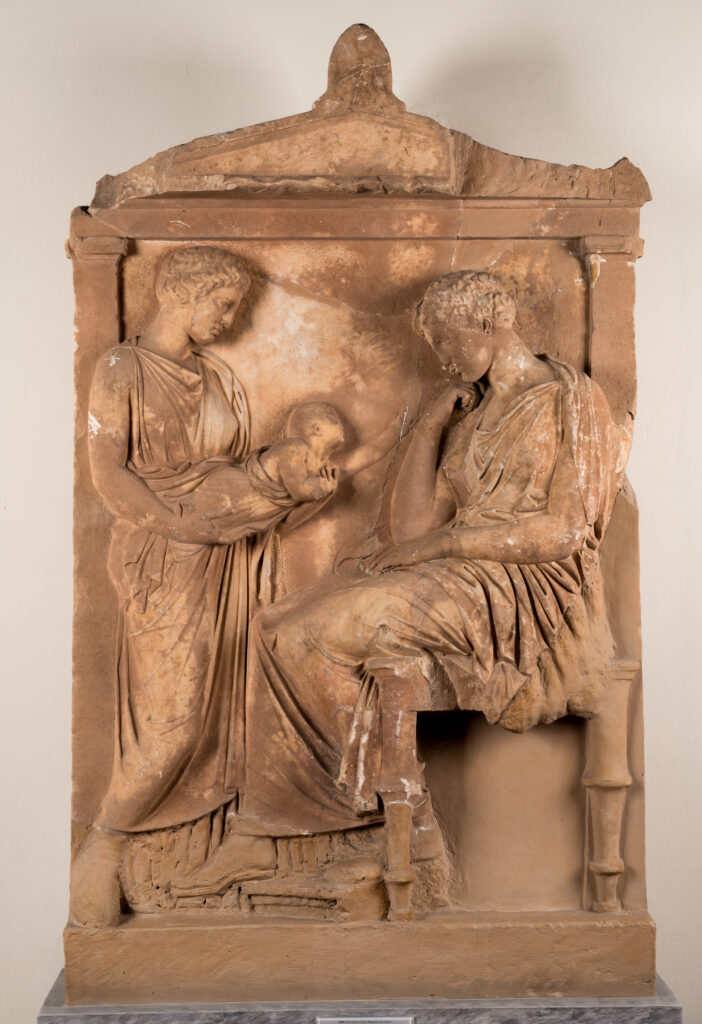Introduction
In the hallowed halls of the National Archaeological Museum in Athens, a poignant relic from ancient times stands as a testament to the profound depths of human emotion. This is the grave stele of Phylonoe, an Athenian young mother who met her untimely end, likely during the act of childbirth, in the year 380 BCE. The story etched into this masterful work of ancient Greek sculpture is one that transcends the boundaries of time, stirring the hearts of all who behold its haunting beauty.

The Tragic Tableau
The grave stele depicts a scene that is both heartbreakingly intimate and profoundly distant. Phylonoe, the young mother, is seated on a stool, her expression one of stoic detachment as she gazes upon her infant son, held in the arms of another woman, presumably a servant or caretaker. The baby, with arms outstretched, desperately reaches for his mother, his passion and longing palpable in every gesture.
Yet, despite their physical proximity, Phylonoe and her child seem worlds apart, separated by the veil of death that has claimed the young woman’s life. Her impassive countenance, devoid of the maternal warmth one might expect, stands in stark contrast to the baby’s anguished plea, creating a tragic dichotomy that tugs at the heartstrings of all who behold it.
The Significance of Athenian Grave Stelae
Grave stelae, such as the one depicting Phylonoe and her infant son, were an integral part of the funerary customs of ancient Athens. These monumental sculptures, often adorned with intricate carvings and inscriptions, served as a means of honoring the deceased and preserving their memory for generations to come.
In the case of Phylonoe, the epigram carved onto the epistyle, or lintel, of the stele provides a poignant glimpse into the life and untimely demise of this young Athenian woman. The inscription, which likely commemorates her passing, suggests that she perished during the act of childbirth, a fate that was all too common in the ancient world.
The Emotional Impact of the Stele
The grave stele of Phylonoe is a profoundly moving work of art, one that elicits a range of emotions from those who witness it. The stark contrast between the mother’s detached expression and the child’s desperate longing for her touch is a haunting depiction of the fragility of life and the cruel realities of death.

Yet, within this tragedy, there is also a sense of tenderness and intimacy. The delicate carving of the figures, the attention to detail in the folds of their garments, and the overall composition of the scene all contribute to a sense of immediacy and personal connection. The viewer is drawn into the moment, compelled to contemplate the depth of the young mother’s loss and the anguish of the child left behind.
The Enduring Legacy of Phylonoe
The grave stele of Phylonoe stands as a testament to the enduring power of art to capture the human experience in all its complexities. Through this poignant work, we are granted a window into the lives of those who lived and loved in the ancient world, their stories and emotions resonating with us even across the vast chasm of time.
In the face of such profound loss, the stele also serves as a reminder of the resilience of the human spirit. Despite the tragedy that befell Phylonoe, her memory lives on, preserved in the intricate carvings and the haunting beauty of the grave marker that bears her name.
Conclusion
The grave stele of Phylonoe is a masterpiece of ancient Greek art, a work that transcends the boundaries of time and space to touch the hearts of all who behold it. In its stark depiction of the contrast between a mother’s eternal gaze and her child’s desperate longing, it speaks to the universal human experience of love, loss, and the bittersweet realities of life and death.
As we stand before this poignant relic, we are reminded of the fragility of our own existence and the enduring power of art to capture the essence of the human condition. The story of Phylonoe, etched in stone, serves as a testament to the resilience of the human spirit and the enduring legacy of those who have come before us.

